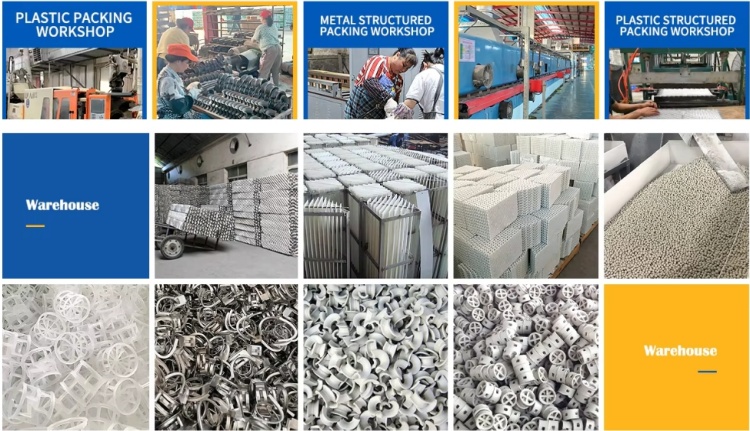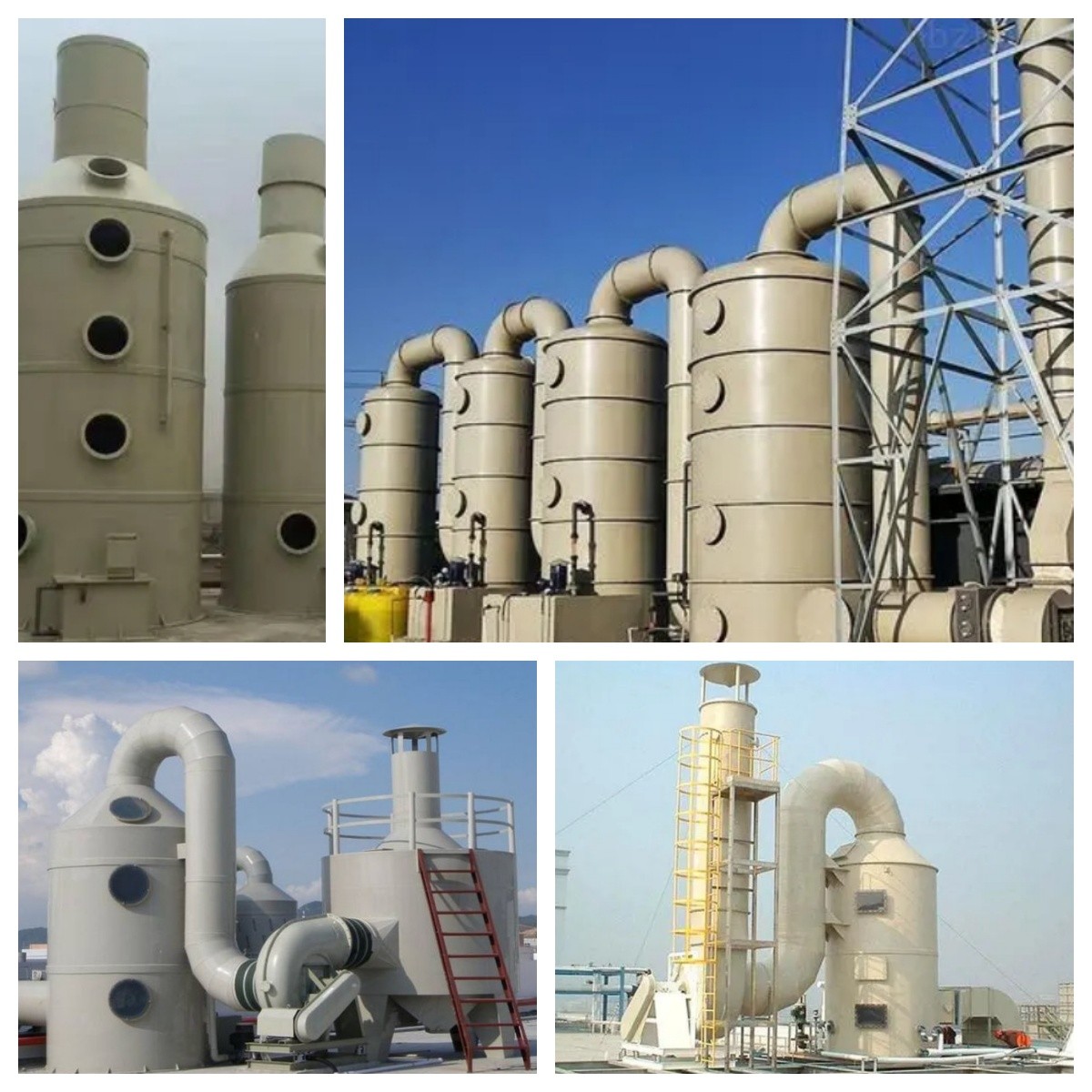A Scrubber Tower is an industrial device primarily used for gas purification and pollution control. It is commonly employed in industries such as chemical processing, oil refining, power generation, and others that produce harmful gases. The scrubber tower removes contaminants from gases by bringing the gases into contact with liquids (such as water, alkaline solutions, or other chemical solutions).
Working Principle of a Scrubber Tower
- Gas enters the tower: The gas to be treated enters the scrubber tower from the bottom or side.
- Contact with liquid: The tower contains spray devices that allow the gas to come into contact with a liquid that is sprayed down from the top. The liquid absorbs or reacts with contaminants in the gas.
- Gas-liquid separation: After the contaminants are absorbed or reacted with the liquid, the treated gas exits from the top of the tower, while the contaminated liquid is collected at the bottom for further treatment or disposal.
- Purification effect: Depending on the type of liquid used in the scrubber tower, the absorption process can remove contaminants such as acidic gases (e.g., sulfur dioxide), particulates, ammonia, or nitrogen oxides.
Types of Scrubber Towers
- Wet Scrubber Tower: Uses a liquid (typically water or chemical solutions) to remove contaminants from the gas. Wet scrubbers are often used for controlling the emission of acidic gases, such as SO₂.
- Dry Scrubber Tower: Uses solid adsorbents (such as activated carbon or limestone) to absorb contaminants from the gas. Dry scrubbers are commonly used to remove volatile organic compounds (VOCs) or acidic gases.
- Spray Tower: A type of wet scrubber where gas interacts with liquid through a spray mechanism. It is frequently used to remove acidic gases and particulates.
Applications of Scrubber Towers
- Flue Gas Desulfurization (FGD): Power plants and industrial boilers often emit sulfur dioxide, which can be effectively removed using scrubber towers.
- VOC Control: Volatile organic compounds (VOCs) can be reduced using dry or wet scrubber towers.
- Dust and NOx Removal: Some scrubber towers are also designed to remove particulates or nitrogen oxides (NOx) from gas streams.
Scrubber towers are essential in environmental control and industrial gas treatment systems, particularly in industries with strict regulations on harmful gas emissions.
Scrubber media play a crucial role in the operation of scrubbers, which are devices designed to remove harmful pollutants from gas streams, particularly in industrial environments. These media enhance the contact between the contaminated gases and the scrubbing liquid or chemicals, ensuring efficient mass transfer and contaminant removal. The choice of scrubber media significantly impacts the effectiveness, efficiency, and operating cost of a scrubber system, making it a key component in environmental protection efforts.
Types of Scrubber Media
There are various types of scrubber media, each designed to meet specific operational needs, depending on the nature of the pollutants, the scrubber design, and the working environment. Below are the most commonly used types:

1. Packed Bed Media
Packed bed scrubbers utilize randomly or systematically arranged media to provide a large surface area for gas-liquid contact. This type of media is highly effective in facilitating the absorption or neutralization of contaminants such as acid gases, volatile organic compounds (VOCs), and particulate matter.
- Examples: tri-packs, lanpac, Pall Ring, Raschig Ring, and heilex ring
- Materials: Polypropylene (PP), Polyvinyl Chloride (PVC), or PVDF
- Applications: Acid gas scrubbers, chemical processing plants, and exhaust treatment systems
2. Ceramic Media
Ceramic media are often used in high-temperature applications where plastics would degrade. They are highly resistant to thermal stress and corrosion, making them ideal for more aggressive gas streams or when heat recovery is necessary.
- Examples: Ceramic heat recovery media used in regenerative thermal oxidizers (RTOs)
- Materials: High-temperature ceramics
- Applications: Industrial furnaces, RTO systems, and chemical reactors
3. Dry Scrubber Media
Dry scrubbers use solid media to adsorb or chemically react with contaminants, often without the need for liquids. This media is commonly used in applications where moisture is undesirable, or liquid handling is too complex or expensive.
- Examples: Activated carbon, catalytic carbon, and potassium permanganate-impregnated alumina
- Applications: Odor control, air purification, and acid gas removal in industrial facilities
4. Demister Mesh and Gas Scrubbing Media
Demister mesh and similar media are used to remove entrained liquid droplets from gas streams, enhancing the efficiency of the scrubbing process. These meshes prevent the loss of scrubbing liquid and ensure that any particulate matter or aerosols in the gas stream are effectively removed.
- Examples: BlueFil® demister mesh
- Materials: Polypropylene, ETFE, or stainless steel
- Applications: Gas-liquid separation systems, mist eliminators in chemical plants, and air pollution control devices
Key Factors to Consider When Selecting Scrubber Media
When selecting scrubber media for a particular system, several factors must be considered to optimize performance:
- Material Compatibility: The media material should be chemically resistant to the pollutants and scrubbing agents involved. For instance, PP and PVC are commonly used for corrosive environments, while ceramics are used in high-temperature conditions.
- Surface Area and Porosity: A higher surface area enhances gas-liquid contact, improving the scrubber’s ability to capture pollutants. Packed bed media, with their intricate shapes and designs, are often chosen for this reason.
- Pressure Drop: The media should offer minimal resistance to the flow of gas to avoid excessive pressure drops, which can increase energy consumption and reduce the overall efficiency of the system.
- Maintenance Requirements: Some media types, particularly ceramic or dry scrubber media, may require less frequent replacement or cleaning, while others, like packed bed media, may need regular maintenance to prevent fouling.
Conclusion
Scrubber media are a fundamental component in the design and operation of scrubber systems, ensuring that harmful pollutants are effectively removed from industrial gas streams. By selecting the right type of media—whether it's packed bed media for high-efficiency absorption, ceramic media for high-temperature environments, or dry scrubber media for moisture-sensitive applications—industries can improve their environmental compliance and operational efficiency. As industries continue to seek more sustainable and cost-effective solutions, advances in scrubber media technology will play an increasingly critical role in achieving these goals.
